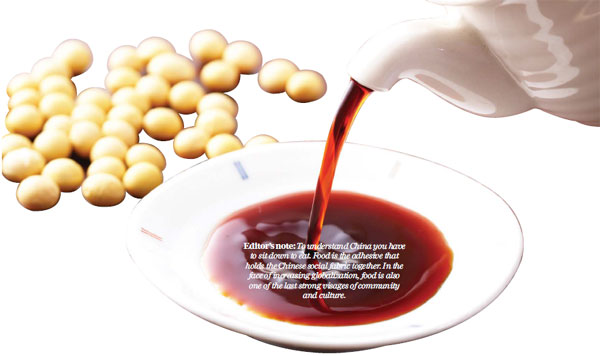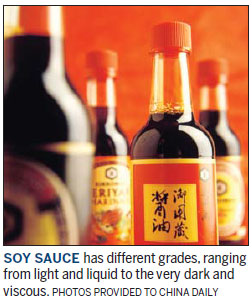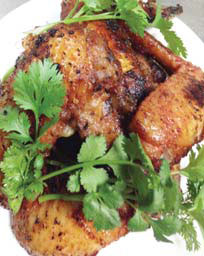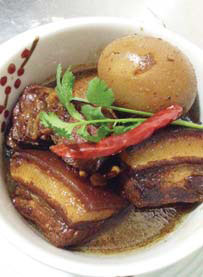Soy sauce Liquid black gold

Editor's note: To understand China you have to sit down to eat. Food is the adhesive that holds the Chinese social fabric together. In the face of increasing globalization, food is also one of the last strong visages of community and culture.
My grandfather was a determined gourmet. He believed the best-tasting dishes came from his own kitchen, and he was tireless in his search for the best ingredients.
If the best was not easily available, he made his own. But when he tried brewing his own soy sauce once, the process brought me face to face with the hard facts of culinary truth.

You see, before you can get the sauce, you have to steam the beans, dust them with flour and then let them ferment long and slow. At one stage, the trays of soybeans develop a thick covering of ugly, gray mold. Not exactly a palatable sight.
Fortunately, the moldy beans are soon poured into a dragon urn and placed under the sun to bake.
After a while, the magic happens, and the moldy beans, now black and wet, start to dissolve into an aromatic liquid - soy sauce.
Grandpa's soy sauce was delicious, and always carefully stowed in covered containers in the cool, dark pantry. I enjoyed it as much as the rest of the family, but I never forgot the mold.
Actually, it is precisely this fermentation process that turns the simple soybean into a huge range of seasonings, from soy sauces to semi-solid bean sauces to the cheese-like curds that are salty and pungent.
Soy sauce itself is divided into different grades, ranging from light and liquid to the very dark and viscous.
The most flavorful is the undiluted "virgin" sauce first drawn from the fermenting urn. It is light amber, and infused with the fragrance of the bean. This is the most expensive and most treasured of all soy sauces, a little like extra virgin olive oil.
As the contents of the fermenting urn ages, the sauce darkens and thickens, and while it loses some fresh flavor, it compensates by acquiring a richness of color that is treasured by chefs for adding depth to their dishes. This is the original dark soy sauce.
Some manufacturers add molasses to thicken and sweeten the soy sauce while certain producers try to enhance the fragrance by adding mushrooms to the process. In Shanghai, a spicy soy sauce is preferred, which tastes very similar to Worcestershire sauce.
Soy sauce, both light and dark, is indispensable to the Chinese kitchen.

As a flavoring, it does not simply make dishes saltier, but adds a distinctive taste that says "Chinese".
Light soy sauce is used as a marinade, added to gravies, and sprinkled on stir-fries. It is also popular as a pickling base, especially in the north, where almost anything from cucumbers to radishes to Chinese artichokes may be soaked in it.
Dark soy sauce is commonly used both as a coloring agent and the base ingredient of many braised dishes such as hongshaorou -the ubiquitous red-braised dish, where belly pork is caramelized in rock sugar and then braised in dark soy sauce infused with cinnamon, nutmeg, star anise and cloves. Hard-boiled eggs and dried mushrooms are often added.
This is one dish that is cooked all over China, from Guangzhou in the south to Beijing up north.
There are also the bean sauces.
Salted black beans and the lighter, softer golden bean sauce are the two most common, although there are regional variations across the country.
The Cantonese are expert at turning salty black beans into a flavorful seasoning, often mincing the dried beans with garlic, ginger and chili before adding it to bitter melon stir-fries or steaming it with bite-sized pork ribs or chicken pieces.
Fried dace (a type of fish) with salted black beans is very popular canned, and generations of Chinese students abroad who had to forage for familiar food in Chinatown grocery stores must remember it fondly.
In Singapore, the famous Geylang beef noodles is stir-fried with this delicious mix, and the beef and rice noodles dish is so popular it has become one of the nation's favorites.
Salted black beans are also used in traditional Chinese medicine, where they are added to prescriptions for stubborn coughs and colds.
In the Chaozhou region of Guangdong province, the lighter golden bean sauce is a staple seasoning on the table, where it is used as a dip for steamed seafood, especially fish.
The salty golden beans are served with thinly shredded ginger and slices of chili, and then served with platters of steamed crabs, prawns and fish. Chaozhou food stalls in Singapore, Malaysia, Thailand and Hong Kong all use copious amounts of this delicious seasoning.
Doujiang, as the bean sauce is called, is also used to flavor braised meats and the spring roll vegetable mix popular in that region.
There are also the bean curd seasonings, which are pieces of soft bean curd that have been slowly salted, spiced and fermented.
There are two main varieties - white and red. The white variety is only lightly spiced, often with red specks of chili on the surface. This is furu, often used to season meats before steaming or frying, or made into a sauce for stir-frying vegetables. In the south, one very common stir-fry is water morning glory (kangkong) with a white fermented beancurd sauce.
Red furu is known as nanru, or southern curds, and its maroon coloring comes from the addition of red wine yeast, which both helps it ferment and gives it a peculiar fragrance.
The red curds are most often used to braise meats like pork belly with dried bamboo shoots. Another famous restaurant dish is a deep-fried chicken wing marinated with mashed nanru and ginger.
The fermented curds are not just used for seasoning. In the north of China, especially, they are called jiangdoufu and eaten like a pickle, or smeared on steamed breads like jam.
It is really a testimony to the ingenuity of our Chinese ancestors that we now enjoy such a varied range of flavors from a single bean.
paulined@chinadaily.com.cn
Two dishes to try
Deep-fried chicken wing with red bean curd marinade

An easy, tasty dish that is excellent paired with beer and great for parties.
6 whole chicken wings, jointed
2 tablespoons nanru
1 tablespoon ginger juice
1 tablespoon honey
Marinade wings with fermented bean curd, ginger juice and honey. Leave for at least an hour. Overnight is better.
Drain wings, and deep-fry once to cook, about 10 minutes. Just before serving, drop into hot oil once more to crisp.
Double-frying will make wings very crisp and tasty. Serve hot.
Braised belly pork in soy sauce

I grew up eating this, so it is true comfort food. We drizzle the flavorful sauce over steaming hot white rice.
500 g belly pork, cut into chunks
6 eggs, hard boiled and shelled
1 cup light soy sauce
1 cup dark soy sauce
1 large piece rock sugar, broken up
4-6 cloves garlic, peeled
1 stick cinnamon, a couple star anise pods, a few cloves
Heat wok and place a little oil and rock sugar in it. When sugar melts, add pork pieces and garlic and toss to coat pork.
Add spices.
When you can smell fragrance from garlic and spices, add soy sauces and just enough water to cover ingredients.
Add the hard-boiled eggs. Simmer till pork is tender.
The dish can be reheated, and actually tastes better the next day.
(China Daily European Weekly 05/13/2016 page21)
Today's Top News
- Takaichi must stop rubbing salt in wounds, retract Taiwan remarks
- Millions vie for civil service jobs
- Chinese landmark trade corridor handles over 5m TEUs
- China holds first national civil service exam since raising eligibility age cap
- Xi's article on CPC self-reform to be published
- Xi stresses improving long-term mechanisms for cyberspace governance






























